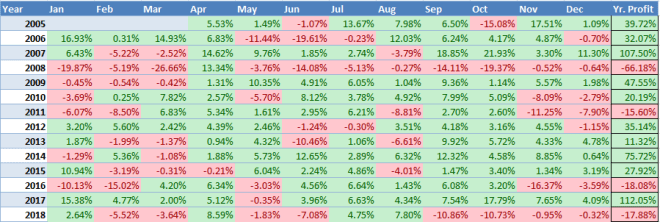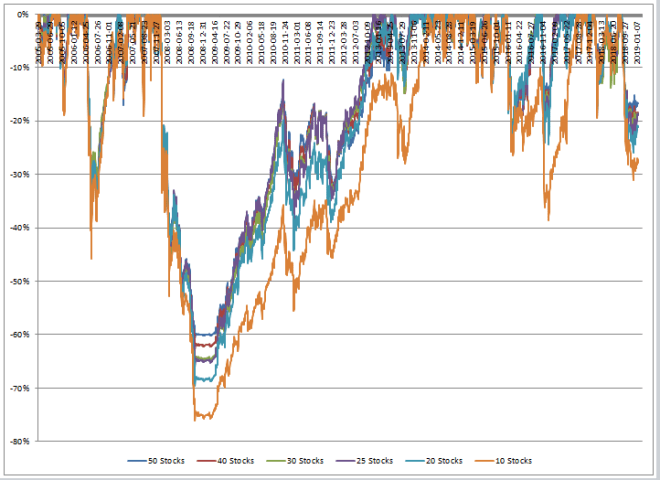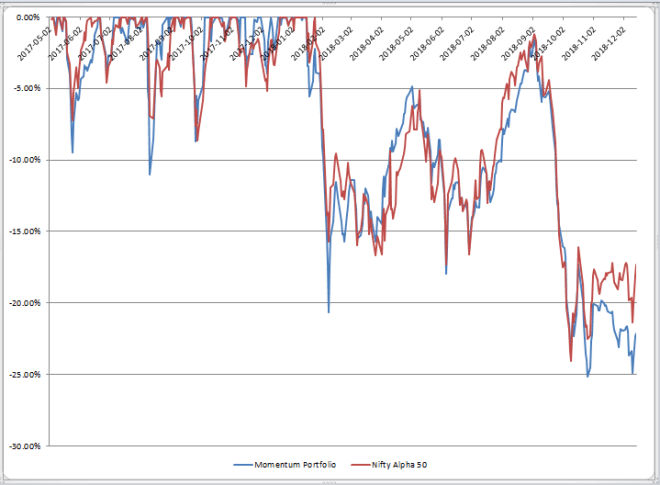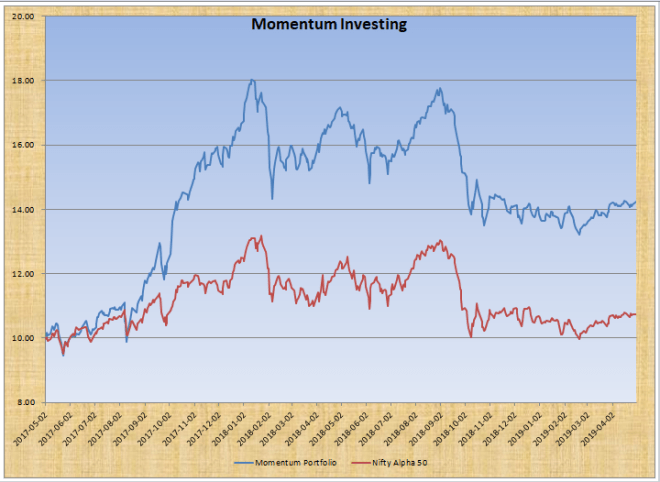“When the student is ready the teacher will appear. When the student is truly ready… The teacher will Disappear.”― Tao Te Ching
2017 in hindsight was a fantastic year for the change in scenery from Bangalore Stock Exchange where I had spent a better part of my time since I came into the market made way for time at the office of Capitalmind.
I have been a systematic trend follower for a long time, but owing to reasons including running inadequate capital, I had never ventured into Systematic Investing in the way I did post my joining Capitalmind.
I wrote about my first year of Momentum Investing last year and thanks to a run-away market, the outcome was way better than what I could expect. 2018-19 though has turned out to be a test though given my own experience in markets post the dot com bubble and the infra bubble of 2008, this isn’t anywhere close to the worst one could expect, it did provide with a deeper look at what to expect and how things could change rapidly.
Two years is still a small period and the performance can only be ascertained to be good or bad post at least a decade. Yet, more the time spent on an endeavour, better one’s understanding and in that respect, 2018 while not fruitful in terms of gains was a good year in terms of understanding the points of strength and failure of the strategy.
When I started trading the strategy, it was more rudimentary in approach based on available data sources. The back-test too was on a smaller data sample. This year, thanks to my friend and mentor, @jace48, I was able to test the strategy comprehensively for the period starting in 2005.
Testing on a long period of data allows one to get a better feel for the strategy though a back-test can never replace real application with all its issues. But without a back-test, risking real money is equivalent to betting blindly in the hope that Lady Luck will always be in one’s favour.
The Back-Test
The strategy was back-tested for the period 2005 to 2018 using the same attributes and filters that is being used in the real world. Since slippage and others costs aren’t taken into account, we need to be aware that the results could slightly overstate the reality. To compensate for that, the returns below were adjusted by removing 0.50% per month (6% return reduced per year)
Of the 165 months in which the strategy was tested, the strategy delivered positive returns in 106 of them versus negative returns in 59 months. 2008, 2011 and 2015 were negative years reflecting the general trend of market being weak during those years.
Momentum or for that matter, any strategy that is long only will fall mostly in line with the broader markets. Risk measured through draw-down from peak or even Volatility of returns and Return compared to other available asset classes are the only way to test whether a strategy is worth pursuing or not.
The results showcased above are for trading a portfolio of 30 stocks, rebalanced monthly. While the logic was 30 was to compensate for the fact that when we trade using momentum, we aren’t really looking to understand neither the nature of the business or the cycle it currently is, testing for different portfolio sizes showed up exactly the same. The optimal portfolio size is between 25 to 30 stocks.
50 Stocks offer the lowest draw-down but returns dwindle as well. On the other hand, if one were to trade just 10 stocks, returns go down the drain while risk explodes. A 50 stock portfolio can be seen as advantageous even though returns are a bit lower if the capital is too large and liquidity is starting to hurt deployment. In most other cases, 25 – 30 stock portfolio should suffice.
Draw-down comparison shows how deep the 10 stock portfolio moves in 2008 versus the best (among the worst) which is 50 stock portfolio. Excluding 2008, while others get close to merging with one another, the 10 stock portfolio draw-down stands out as the worst at any point of time.
Now the Reality:
In 2018, the strategy delivered a loss in 8 of the 12 months. But the standout was that the loss for the calendar year was just 15.57% which was more inline with performance of Nifty Mid Cap 100. This even though we began the year with a median portfolio market capitalization of just 5000 crores which put the portfolio well and truly into the Small Cap bracket.
Confidence in strategy is the only way one can sustain the barrage of weakness we saw in markets and which was reflected in the portfolio loosing for a consecutive 6 months through 2018-19. If not for the back-test and the reading which provided a better understanding of what to expect, its easy to see why investors would rather cut position and wait in cash than continue to take all trades as the strategy expects one to.
The portfolio had a max draw-down of 25% though its bit disappointing to see that we haven’t yet recovered from that fall with the current draw-down still at 20% from the peaks we had reached in January of 2018. The equity curve chart pattern though offers some hope J
Be it Momentum or Value, strategies that require one to track portfolio’s, change as required and be up to date on what’s happening if only worth the time and trouble if the returns are more than what one could have achieved by just buying a simple ETF or Mutual Fund.
Since the momentum strategy is agnostic to market capitalization, the best benchmark would be the performance of multi-cap funds over the same period. The best fund over this 2 year horizon is SBI Focussed Equity Fund which in its Direct plan which delivered a CAGR return of 15.37%. Adjusted for AUM, the overall returns from all Multicap funds came to 9%.
Comparatively, despite the multiple months of negative returns, the strategy ended year 2 of operation with 18% CAGR returns. While this is still below what top class fund managers target and return, given the early days and the overall market environment, feel its not something to sneered at.
Here is the NAV chart from start;
I have compared the performance against Nifty Alpha 50 since that is the index that matches the philosophy of the system though it being limited to the top 200 stocks works against it during good times while saving it during bad (lower draw-downs).
Recently, well known Value Investor Rohit Chauhan shared the performance of advisory model portfolio over the last 8 years. What was amazing was that the performance was very close to the back-test results of my own Momentum Strategy (with Momentum doing slightly better). But better or worse is not the question, the fact is that systematically following a strategy can for the investor deliver more than what markets in general can.
I hope that I can continue to invest and grow the capital and showcase a decade of performance 8 years from now. This post is an attempt to enable a better understanding of momentum as an investment strategy that can stand against other factors on its own merits.
I had recently given a talk at Bangalore Investors Group. You can check out the slides here.








Is it based on EOD closing price? Max DD of 66% is massive in 2008. would be hard to stick to strategy with that kind of drawdown
Yes, its based on closing prices. And agree completely that tough, especially if one is new to the strategy.
Well it helps , that most of these momentum portfolios would have atleast doubled or tripled in 2007. How was June ? pretty tricky month for momentum stocks, Lot of them sold of on back of good news in may end
Sir, is the monthly return chart since 2005 also represent the Capitalmind momentum smallcase? Asking since you had somewhere mentioned that the capital mind one has a slightly more stricter selection criteria.
Its similar (other than for Liquidity factor) to Capitalmind Momentum PMS. Capitalmind Advisory Momentum Portfolio follows a different selection strategy.
Thank you for sharing this blog. This is really informative.
Very informative.
In which indices stocks to be selected for Momentum investing? Nifty100 ,nifty500 or nifty alpha low volatility 30 index etc
Broader the Index, more the number of choices you have for selection. I don’t filter by Indices since a lot of stocks can show Momentum while being outside the rule based Indices